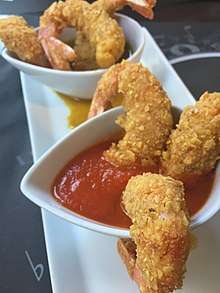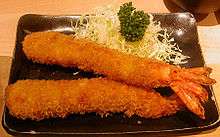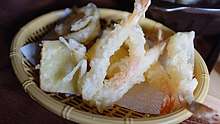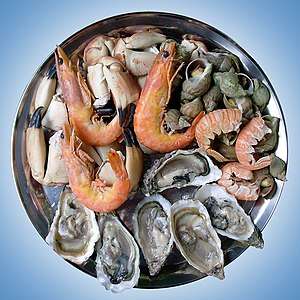Fried shrimp
Fried shrimp or fried prawn is deep-fried shrimp and prawns.

In the world
Japan

ebi furai (海老フライ or エビフライ) is a deep fried dish popular in Japan as well as Japanese restaurants worldwide. It is a speciality of the city of Nagoya.
A popular ingredient of Japanese bento, Fried Prawn Bentō (海老フライ弁当 or エビフライ弁当, ebi furai) is a common menu item at bentō shops.
Traditionally Kuruma Ebi was used, but since a decline in its cultivation, many stores have started using black tiger shrimp and Ise Ebi. It is thought that ebi furai was created around 1900 in response to the growing popularity of similar dishes such as Tonkatsu and minced meat cutlets in the Western food restaurants of Ginza and Tokyo.
Each prawn is straightened out flat, and a small incision made along its back. The gritty tasting digestive tract is then pulled out of this incision. The prawn is then coated with flour, beaten egg and Japanese breadcrumbs Panko in that order, and deep-fried in hot cooking oil. The head is usually removed before cooking. However, if the prawn is fresh enough, it may be cooked and served whole. Some people prefer to eat the head, which becomes crispy. Fried prawns are often eaten with a choice of thick Worcester sauce, Hoisin sauce, lemon juice or tartare sauce.
- Ebi-don (海老丼 or エビ丼, fried prawn and egg over rice) - the prawns are brushed with egg only, and placed on top of a bowl of hot rice.
Ebi furai is acknowledged as one of Nagoya's specialty foods mainly due to a joke made by the popular Japanese tarento (celebrity) Tamori about ebi furai being called ebi furyaa in the Nagoya dialect. Whilst this term did not exist in the Nagoya dialect prior to his joke, as foreign loan words generally do not change in Japanese dialects, it led a large portion of his audiences to believe that this was an extant variant used in the Nagoya area.[1]
Korea

In Korean cuisine, fried shrimp is known as saeu-twigim (새우튀김). Along with ojingeo-twigim (fried squid) and other twigims, it is a common street food and a bunsikjip (snack bar) item. It is also a common anju (food accompanying alcoholic drinks) for beer.[2]
Philippines
_from_Vigan%2C_Philippines.jpg)
Fried shrimp dishes in Philippine cuisine include camaron rebosado (battered shrimp), okoy (battered shrimp pancakes), halabos na hipon (fried or boiled shrimp cooked in its own juices or carbonated soda), and nilasing na hipon (battered shrimp marinated in alcohol), among others.[3]
Camaron rebosado is a deep-fried battered shrimp typically served with sweet and sour sauce. It is made by peeling large shrimp and marinating it in a mixture of calamansi juice, salt, and black pepper. It is then coated with a batter made from egg, flour, and corn starch before deep frying.[3][4]
Okoy is another native Filipino deep-fried dish that typically use small unshelled shrimp. The batter is uniquely traditionally made from galapong (ground soaked glutinous rice), mixed with calabaza, sweet potatoes, or cassava and various vegetables like carrots, onions, and green papaya. It is deep-fried into flat crispy pancakes and traditionally served with a vinegar-based dipping sauce.[5]
See also
Notes
References
- ちょっとほろ苦い!?海老ふりゃあ
- Seo, Jung-min (26 February 2018). "Gyeoul-ollimpik pyemak-sik ttae eotteon maekju masilkka... Bulssajo vs Pyeongchang". JoongAng Ilbo (in Korean). Retrieved 25 March 2018.
- "Camaron Rebosado". Kawaling Pinoy. Retrieved 16 December 2018.
- Polistico, Edgie (2017). Philippine Food, Cooking, & Dining Dictionary. Anvil Publishing, Incorporated. ISBN 9786214200870.
- Williams, Sean (2013). The Ethnomusicologists' Cookbook: Complete Meals from Around the World. Routledge. p. 82. ISBN 9781135518967.

